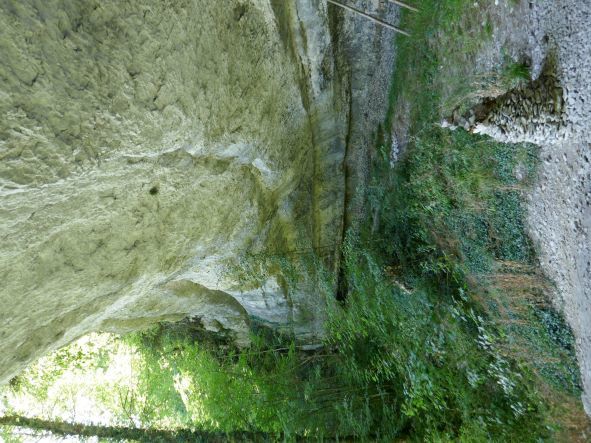

Un abri sous roche est une cavité peu profonde s'enfonçant dans une paroi rocheuse, souvent à la base de celle-ci car cette partie froide et humide est plus sensible à la cryoclastie. De tels abris sont particulièrement fréquents dans les massifs calcaires, en contexte karstique, où ils sont creusés au cours des millénaires par la gélifraction (érosion par le gel et le dégel) et/ou l'érosion chimique (dissolution). On en rencontre également mais plus rarement dans d'autres types de roches, notamment les roches volcaniques (basaltes par exemple).
Ce type de cavité largement ouverte et protégée par un surplomb (encorbellement plus ou moins important pouvant s'effondrer en gros blocs et amorcer la formation d'un nouvel abri sous roche) fut très souvent occupée par l'homme préhistorique en quête d'abris aérés et faciles d'accès, de façon permanente (habitat, sépulture) ou occasionnelle (campement saisonnier, halte de chasse, atelier...).
En géologie, il y a plusieurs manières pour que l'action de l'érosion crée un abri sous roche !
A - Par cryoclastie ou gélifraction (action des phases de gel / dégel) :

B - Par la coupe d'une galerie karstique déjà existante :

C - Par l'érosion hydraulique :

L'earthcache :
Pour loguer cette EarthCache, rendez-vous aux coordonnées, et répondez aux questions suivantes.
Attention : le relief a pu perturber notre relevé des coordonnées GPS...
1 ► Observez et décrivez les pierres sous l'abri. Qu'en concluez-vous ?
2 ► Selon vous, en vous basant sur les schémas A, B et C, quel est(sont) le(s) processus à l'origine de cet abri ? Justifiez votre réponse
3 ► Quel autre élément, présent sur le site, a pu accélérer la création de l'abris sous roche ? Justifiez votre réponse
4 ► Joignez à votre log une photographie permettant ou non de vous identifier (visage, GPS, pseudo, etc.) sur le site... mais sans montrer des éléments qui pourraient compromettre la résolution de la cache. Rien d'obligatoire mais très apprécié : Soyez créatif !
Rappels concernant les « EarthCaches » :
Il n’y a pas de contenant à rechercher aux coordonnées, ni de carnet à signer sur place. Il suffit de se rendre sur les lieux, de répondre aux questions ci-dessus, et de nous envoyer vos propositions de réponse soit via notre profil, soit la messagerie geocaching.com (Message Center).
Vous pouvez loguer un « Found it » sans attendre notre confirmation. Nous vous contacterons en cas de problème ou pour fournir d’éventuelles précisions.
Les « Found it » enregistrés sans envoi de réponses seront supprimés.
Bon Géocaching !
A rock shelter is a shallow cavity in a rock face, often at the base of the rock face because this cold and wet area is more susceptible to cryoclastic formation. Such shelters are particularly frequent in limestone massifs, in a karstic context, where they are dug over the millennia by gelifraction (erosion by freezing and thawing) and/or chemical erosion (dissolution). They are also found, but more rarely, in other types of rock, particularly volcanic rocks (e.g. basalts).
This type of cavity, which is wide open and protected by an overhang (a more or less large overhang that can collapse into large blocks and initiate the formation of a new rock shelter), was very often occupied by prehistoric man in search of airy and easily accessible shelters, either permanently (habitat, burial site) or occasionally (seasonal camp, hunting lodge, workshop, etc.).
In geology, there are several ways in which the action of erosion creates a rock shelter!
A - By cryoclastia or gelifraction (action of freezing/thawing phases):

B - By cutting an existing karst gallery:

C - By hydraulic erosion :

The earthcache :
To log this EarthCache, go to the coordinates and answer the following questions.
Please note that the terrain may have interfered with our GPS coordinates...
1 ► Observe and describe the stones under the shelter. What do you conclude from this?
2 ► According to you, based on diagrams A, B and C, what is (are) the process(es) at the origin of this shelter? Justify your answer
3 ► What other element, present on the site, could have accelerated the creation of the rock shelter? Justify your answer
4 ► Attach a photograph to your log that may or may not identify you (face, GPS, nickname, etc.) on the site... but without showing anything that might compromise the resolution of the cache. Nothing compulsory but much appreciated: be creative!
Reminders about the “EarthCaches”:
There is no container to look for nor a logbook to sign. Just go to the location, answer the questions above, and send us your proposals of answers either via our profile or Message Center.
You can log “Found it” without waiting for our validation. We will contact you in case of problems or to provide any clarification.
“Found it” logs saved without sending answers will be deleted.
Happy geocaching
Source images : Wkipedia